Exploring Geometry and Measurement for Children Under 12 Years: Shapes
VerifiedAdded on 2022/11/26
|9
|2342
|452
Literature Review
AI Summary
This literature review examines the development of geometry and measurement skills in children under 12, emphasizing the crucial role of shapes in building cognitive abilities. The review highlights the interconnectedness of geometry and measurement, advocating for their integrated teaching. It explores the significance of early exposure to geometric concepts, the importance of designing appropriate learning environments that foster creativity and safety, and the use of diverse activities and resources, including shape sorters, shape hunts, and pattern blocks. The review also addresses learning trajectories, common misconceptions, and the need for teachers to recognize and leverage individual student abilities. The study underscores the impact of a well-structured learning environment on children's emotional, social, and cognitive development, stressing the need for age-appropriate instruction and the use of engaging resources. It emphasizes that children’s understanding of shapes forms the basis for abstract thinking and logical reasoning, which are applicable across multiple fields.
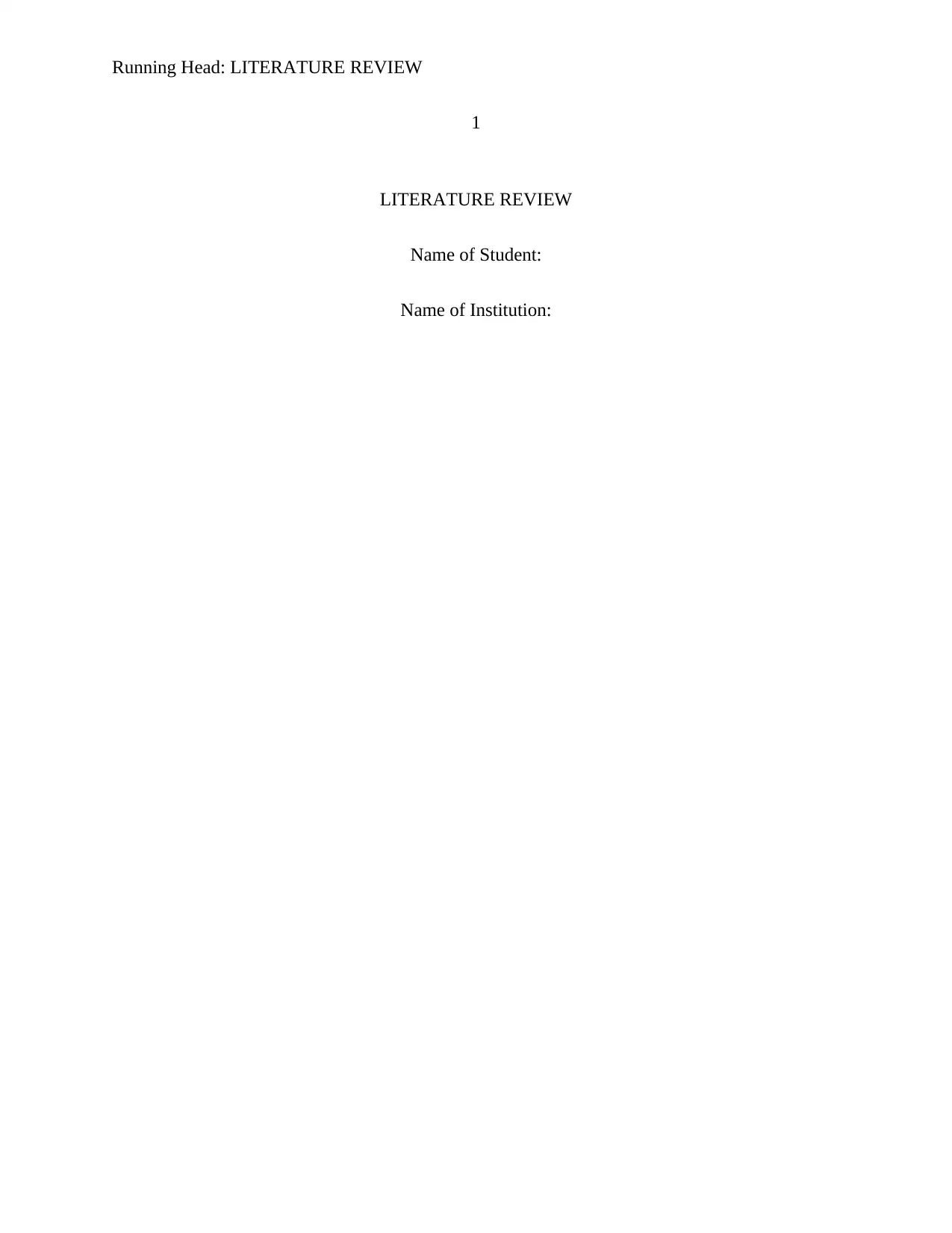
Running Head: LITERATURE REVIEW
1
LITERATURE REVIEW
Name of Student:
Name of Institution:
1
LITERATURE REVIEW
Name of Student:
Name of Institution:
Paraphrase This Document
Need a fresh take? Get an instant paraphrase of this document with our AI Paraphraser
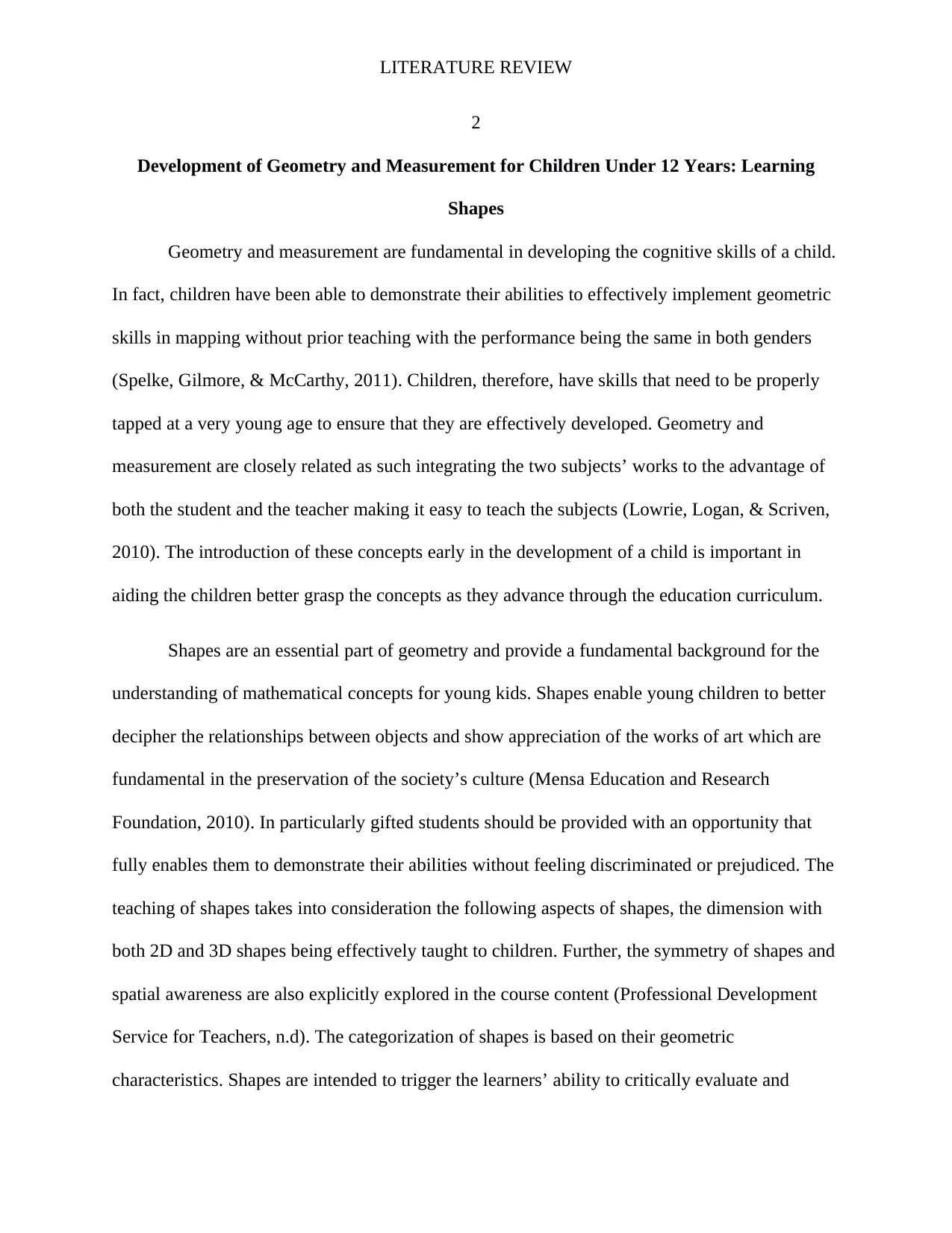
LITERATURE REVIEW
2
Development of Geometry and Measurement for Children Under 12 Years: Learning
Shapes
Geometry and measurement are fundamental in developing the cognitive skills of a child.
In fact, children have been able to demonstrate their abilities to effectively implement geometric
skills in mapping without prior teaching with the performance being the same in both genders
(Spelke, Gilmore, & McCarthy, 2011). Children, therefore, have skills that need to be properly
tapped at a very young age to ensure that they are effectively developed. Geometry and
measurement are closely related as such integrating the two subjects’ works to the advantage of
both the student and the teacher making it easy to teach the subjects (Lowrie, Logan, & Scriven,
2010). The introduction of these concepts early in the development of a child is important in
aiding the children better grasp the concepts as they advance through the education curriculum.
Shapes are an essential part of geometry and provide a fundamental background for the
understanding of mathematical concepts for young kids. Shapes enable young children to better
decipher the relationships between objects and show appreciation of the works of art which are
fundamental in the preservation of the society’s culture (Mensa Education and Research
Foundation, 2010). In particularly gifted students should be provided with an opportunity that
fully enables them to demonstrate their abilities without feeling discriminated or prejudiced. The
teaching of shapes takes into consideration the following aspects of shapes, the dimension with
both 2D and 3D shapes being effectively taught to children. Further, the symmetry of shapes and
spatial awareness are also explicitly explored in the course content (Professional Development
Service for Teachers, n.d). The categorization of shapes is based on their geometric
characteristics. Shapes are intended to trigger the learners’ ability to critically evaluate and
2
Development of Geometry and Measurement for Children Under 12 Years: Learning
Shapes
Geometry and measurement are fundamental in developing the cognitive skills of a child.
In fact, children have been able to demonstrate their abilities to effectively implement geometric
skills in mapping without prior teaching with the performance being the same in both genders
(Spelke, Gilmore, & McCarthy, 2011). Children, therefore, have skills that need to be properly
tapped at a very young age to ensure that they are effectively developed. Geometry and
measurement are closely related as such integrating the two subjects’ works to the advantage of
both the student and the teacher making it easy to teach the subjects (Lowrie, Logan, & Scriven,
2010). The introduction of these concepts early in the development of a child is important in
aiding the children better grasp the concepts as they advance through the education curriculum.
Shapes are an essential part of geometry and provide a fundamental background for the
understanding of mathematical concepts for young kids. Shapes enable young children to better
decipher the relationships between objects and show appreciation of the works of art which are
fundamental in the preservation of the society’s culture (Mensa Education and Research
Foundation, 2010). In particularly gifted students should be provided with an opportunity that
fully enables them to demonstrate their abilities without feeling discriminated or prejudiced. The
teaching of shapes takes into consideration the following aspects of shapes, the dimension with
both 2D and 3D shapes being effectively taught to children. Further, the symmetry of shapes and
spatial awareness are also explicitly explored in the course content (Professional Development
Service for Teachers, n.d). The categorization of shapes is based on their geometric
characteristics. Shapes are intended to trigger the learners’ ability to critically evaluate and
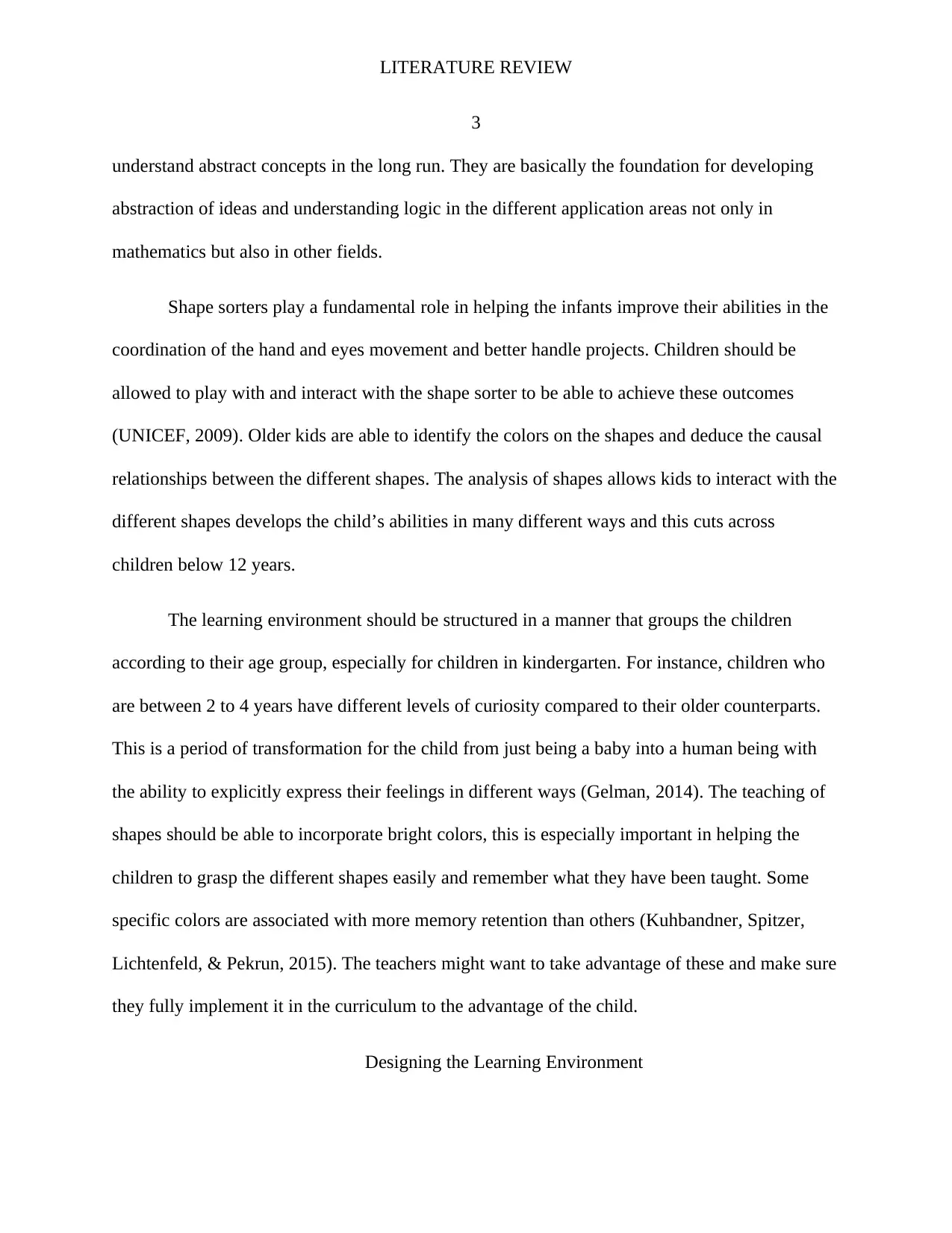
LITERATURE REVIEW
3
understand abstract concepts in the long run. They are basically the foundation for developing
abstraction of ideas and understanding logic in the different application areas not only in
mathematics but also in other fields.
Shape sorters play a fundamental role in helping the infants improve their abilities in the
coordination of the hand and eyes movement and better handle projects. Children should be
allowed to play with and interact with the shape sorter to be able to achieve these outcomes
(UNICEF, 2009). Older kids are able to identify the colors on the shapes and deduce the causal
relationships between the different shapes. The analysis of shapes allows kids to interact with the
different shapes develops the child’s abilities in many different ways and this cuts across
children below 12 years.
The learning environment should be structured in a manner that groups the children
according to their age group, especially for children in kindergarten. For instance, children who
are between 2 to 4 years have different levels of curiosity compared to their older counterparts.
This is a period of transformation for the child from just being a baby into a human being with
the ability to explicitly express their feelings in different ways (Gelman, 2014). The teaching of
shapes should be able to incorporate bright colors, this is especially important in helping the
children to grasp the different shapes easily and remember what they have been taught. Some
specific colors are associated with more memory retention than others (Kuhbandner, Spitzer,
Lichtenfeld, & Pekrun, 2015). The teachers might want to take advantage of these and make sure
they fully implement it in the curriculum to the advantage of the child.
Designing the Learning Environment
3
understand abstract concepts in the long run. They are basically the foundation for developing
abstraction of ideas and understanding logic in the different application areas not only in
mathematics but also in other fields.
Shape sorters play a fundamental role in helping the infants improve their abilities in the
coordination of the hand and eyes movement and better handle projects. Children should be
allowed to play with and interact with the shape sorter to be able to achieve these outcomes
(UNICEF, 2009). Older kids are able to identify the colors on the shapes and deduce the causal
relationships between the different shapes. The analysis of shapes allows kids to interact with the
different shapes develops the child’s abilities in many different ways and this cuts across
children below 12 years.
The learning environment should be structured in a manner that groups the children
according to their age group, especially for children in kindergarten. For instance, children who
are between 2 to 4 years have different levels of curiosity compared to their older counterparts.
This is a period of transformation for the child from just being a baby into a human being with
the ability to explicitly express their feelings in different ways (Gelman, 2014). The teaching of
shapes should be able to incorporate bright colors, this is especially important in helping the
children to grasp the different shapes easily and remember what they have been taught. Some
specific colors are associated with more memory retention than others (Kuhbandner, Spitzer,
Lichtenfeld, & Pekrun, 2015). The teachers might want to take advantage of these and make sure
they fully implement it in the curriculum to the advantage of the child.
Designing the Learning Environment
⊘ This is a preview!⊘
Do you want full access?
Subscribe today to unlock all pages.

Trusted by 1+ million students worldwide
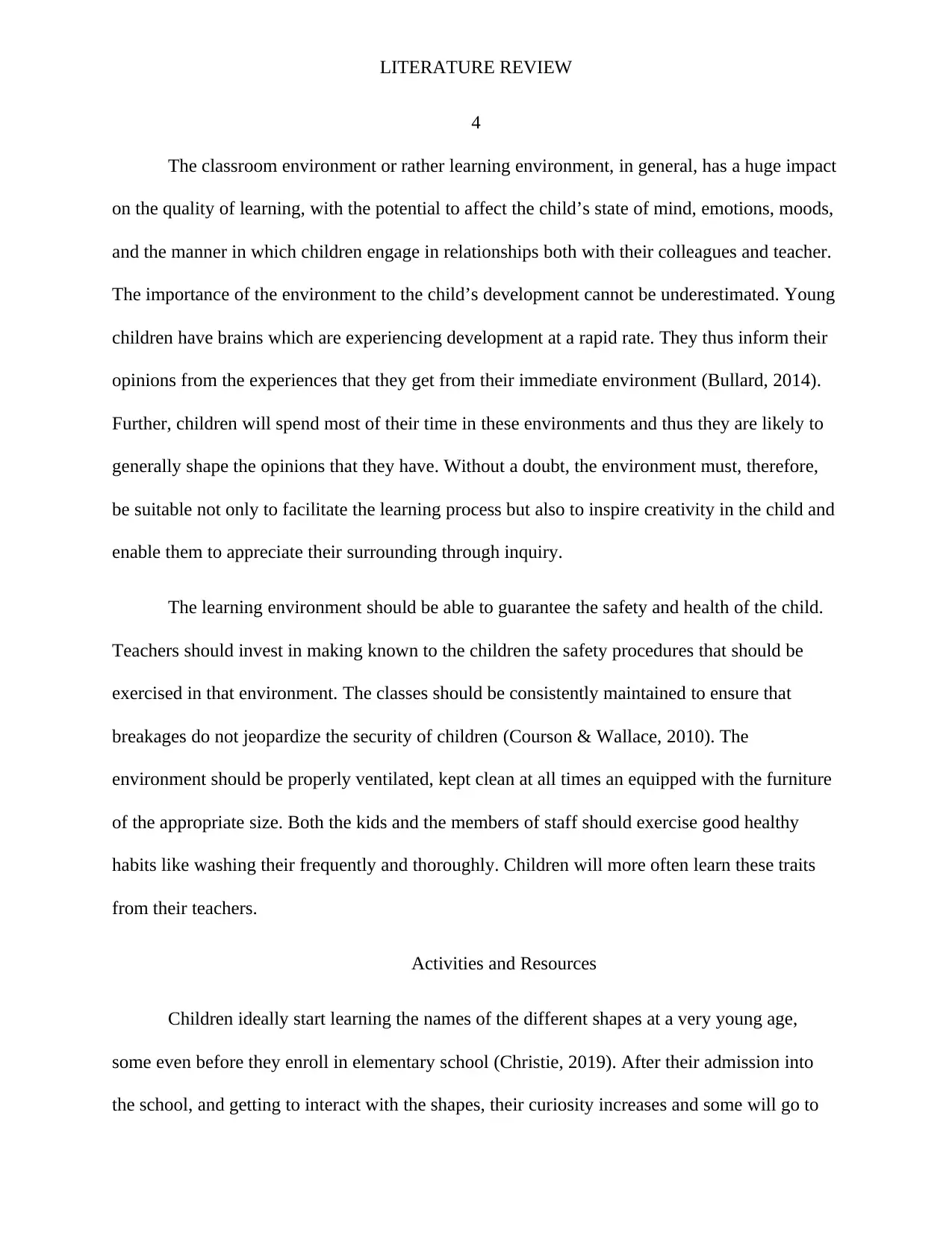
LITERATURE REVIEW
4
The classroom environment or rather learning environment, in general, has a huge impact
on the quality of learning, with the potential to affect the child’s state of mind, emotions, moods,
and the manner in which children engage in relationships both with their colleagues and teacher.
The importance of the environment to the child’s development cannot be underestimated. Young
children have brains which are experiencing development at a rapid rate. They thus inform their
opinions from the experiences that they get from their immediate environment (Bullard, 2014).
Further, children will spend most of their time in these environments and thus they are likely to
generally shape the opinions that they have. Without a doubt, the environment must, therefore,
be suitable not only to facilitate the learning process but also to inspire creativity in the child and
enable them to appreciate their surrounding through inquiry.
The learning environment should be able to guarantee the safety and health of the child.
Teachers should invest in making known to the children the safety procedures that should be
exercised in that environment. The classes should be consistently maintained to ensure that
breakages do not jeopardize the security of children (Courson & Wallace, 2010). The
environment should be properly ventilated, kept clean at all times an equipped with the furniture
of the appropriate size. Both the kids and the members of staff should exercise good healthy
habits like washing their frequently and thoroughly. Children will more often learn these traits
from their teachers.
Activities and Resources
Children ideally start learning the names of the different shapes at a very young age,
some even before they enroll in elementary school (Christie, 2019). After their admission into
the school, and getting to interact with the shapes, their curiosity increases and some will go to
4
The classroom environment or rather learning environment, in general, has a huge impact
on the quality of learning, with the potential to affect the child’s state of mind, emotions, moods,
and the manner in which children engage in relationships both with their colleagues and teacher.
The importance of the environment to the child’s development cannot be underestimated. Young
children have brains which are experiencing development at a rapid rate. They thus inform their
opinions from the experiences that they get from their immediate environment (Bullard, 2014).
Further, children will spend most of their time in these environments and thus they are likely to
generally shape the opinions that they have. Without a doubt, the environment must, therefore,
be suitable not only to facilitate the learning process but also to inspire creativity in the child and
enable them to appreciate their surrounding through inquiry.
The learning environment should be able to guarantee the safety and health of the child.
Teachers should invest in making known to the children the safety procedures that should be
exercised in that environment. The classes should be consistently maintained to ensure that
breakages do not jeopardize the security of children (Courson & Wallace, 2010). The
environment should be properly ventilated, kept clean at all times an equipped with the furniture
of the appropriate size. Both the kids and the members of staff should exercise good healthy
habits like washing their frequently and thoroughly. Children will more often learn these traits
from their teachers.
Activities and Resources
Children ideally start learning the names of the different shapes at a very young age,
some even before they enroll in elementary school (Christie, 2019). After their admission into
the school, and getting to interact with the shapes, their curiosity increases and some will go to
Paraphrase This Document
Need a fresh take? Get an instant paraphrase of this document with our AI Paraphraser
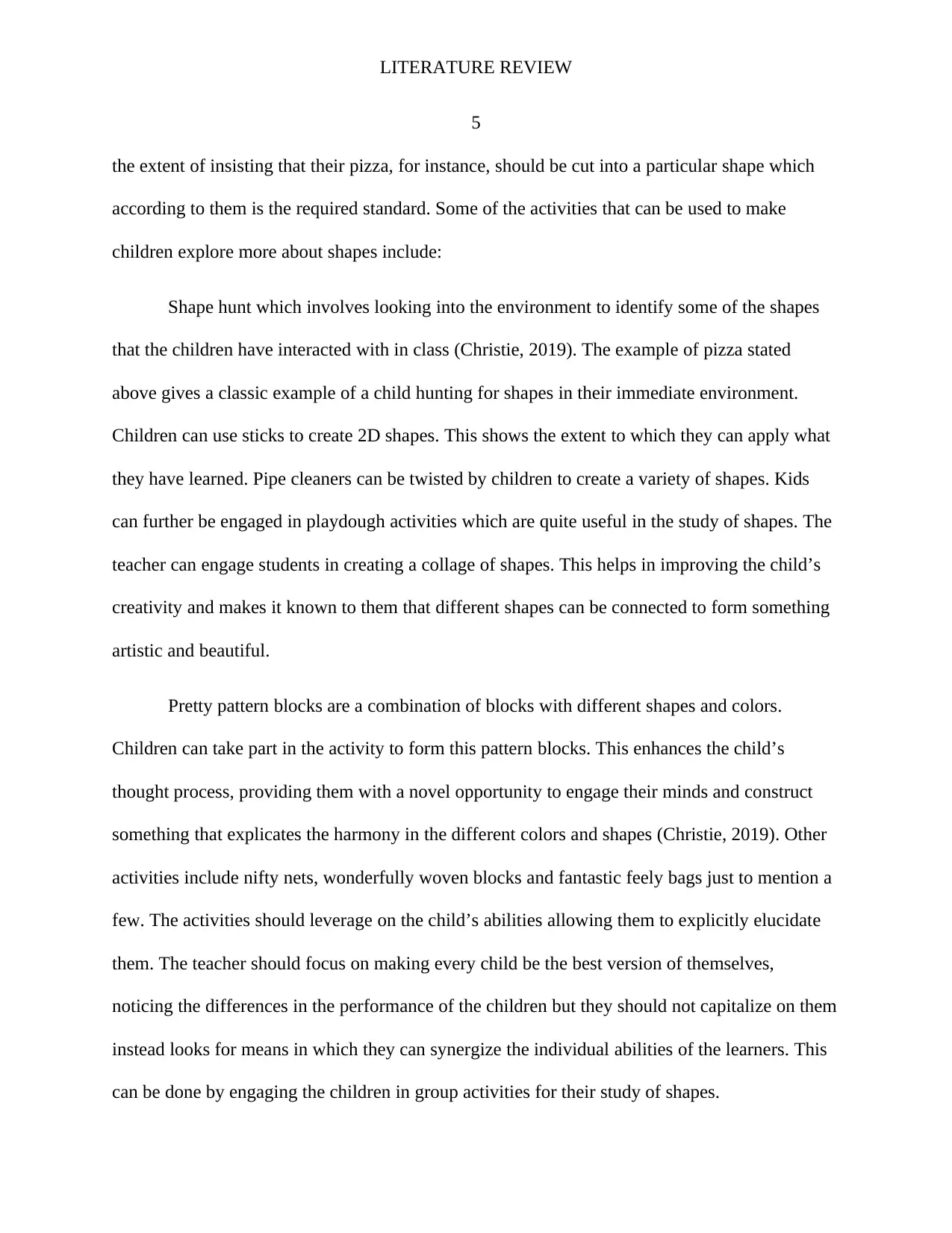
LITERATURE REVIEW
5
the extent of insisting that their pizza, for instance, should be cut into a particular shape which
according to them is the required standard. Some of the activities that can be used to make
children explore more about shapes include:
Shape hunt which involves looking into the environment to identify some of the shapes
that the children have interacted with in class (Christie, 2019). The example of pizza stated
above gives a classic example of a child hunting for shapes in their immediate environment.
Children can use sticks to create 2D shapes. This shows the extent to which they can apply what
they have learned. Pipe cleaners can be twisted by children to create a variety of shapes. Kids
can further be engaged in playdough activities which are quite useful in the study of shapes. The
teacher can engage students in creating a collage of shapes. This helps in improving the child’s
creativity and makes it known to them that different shapes can be connected to form something
artistic and beautiful.
Pretty pattern blocks are a combination of blocks with different shapes and colors.
Children can take part in the activity to form this pattern blocks. This enhances the child’s
thought process, providing them with a novel opportunity to engage their minds and construct
something that explicates the harmony in the different colors and shapes (Christie, 2019). Other
activities include nifty nets, wonderfully woven blocks and fantastic feely bags just to mention a
few. The activities should leverage on the child’s abilities allowing them to explicitly elucidate
them. The teacher should focus on making every child be the best version of themselves,
noticing the differences in the performance of the children but they should not capitalize on them
instead looks for means in which they can synergize the individual abilities of the learners. This
can be done by engaging the children in group activities for their study of shapes.
5
the extent of insisting that their pizza, for instance, should be cut into a particular shape which
according to them is the required standard. Some of the activities that can be used to make
children explore more about shapes include:
Shape hunt which involves looking into the environment to identify some of the shapes
that the children have interacted with in class (Christie, 2019). The example of pizza stated
above gives a classic example of a child hunting for shapes in their immediate environment.
Children can use sticks to create 2D shapes. This shows the extent to which they can apply what
they have learned. Pipe cleaners can be twisted by children to create a variety of shapes. Kids
can further be engaged in playdough activities which are quite useful in the study of shapes. The
teacher can engage students in creating a collage of shapes. This helps in improving the child’s
creativity and makes it known to them that different shapes can be connected to form something
artistic and beautiful.
Pretty pattern blocks are a combination of blocks with different shapes and colors.
Children can take part in the activity to form this pattern blocks. This enhances the child’s
thought process, providing them with a novel opportunity to engage their minds and construct
something that explicates the harmony in the different colors and shapes (Christie, 2019). Other
activities include nifty nets, wonderfully woven blocks and fantastic feely bags just to mention a
few. The activities should leverage on the child’s abilities allowing them to explicitly elucidate
them. The teacher should focus on making every child be the best version of themselves,
noticing the differences in the performance of the children but they should not capitalize on them
instead looks for means in which they can synergize the individual abilities of the learners. This
can be done by engaging the children in group activities for their study of shapes.
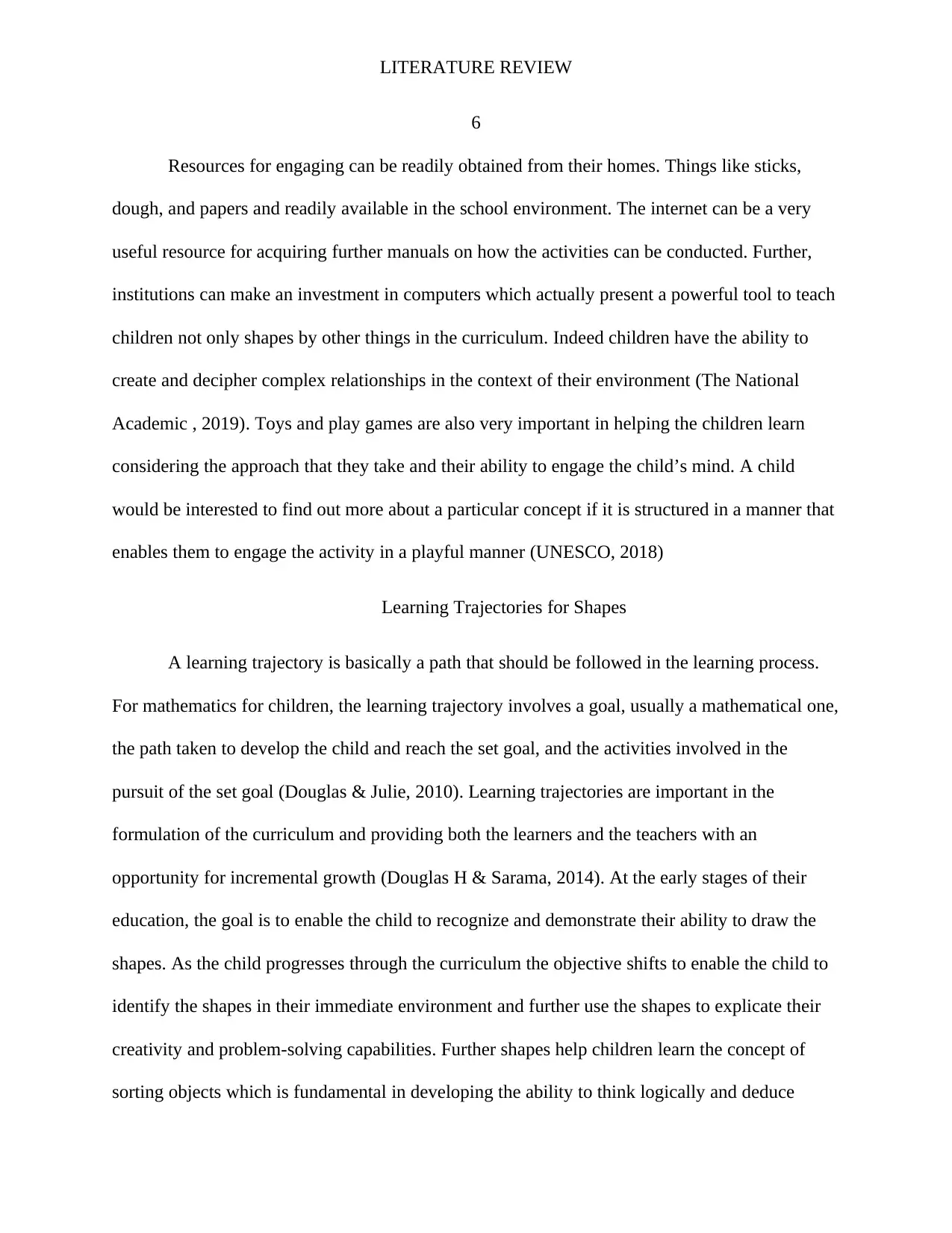
LITERATURE REVIEW
6
Resources for engaging can be readily obtained from their homes. Things like sticks,
dough, and papers and readily available in the school environment. The internet can be a very
useful resource for acquiring further manuals on how the activities can be conducted. Further,
institutions can make an investment in computers which actually present a powerful tool to teach
children not only shapes by other things in the curriculum. Indeed children have the ability to
create and decipher complex relationships in the context of their environment (The National
Academic , 2019). Toys and play games are also very important in helping the children learn
considering the approach that they take and their ability to engage the child’s mind. A child
would be interested to find out more about a particular concept if it is structured in a manner that
enables them to engage the activity in a playful manner (UNESCO, 2018)
Learning Trajectories for Shapes
A learning trajectory is basically a path that should be followed in the learning process.
For mathematics for children, the learning trajectory involves a goal, usually a mathematical one,
the path taken to develop the child and reach the set goal, and the activities involved in the
pursuit of the set goal (Douglas & Julie, 2010). Learning trajectories are important in the
formulation of the curriculum and providing both the learners and the teachers with an
opportunity for incremental growth (Douglas H & Sarama, 2014). At the early stages of their
education, the goal is to enable the child to recognize and demonstrate their ability to draw the
shapes. As the child progresses through the curriculum the objective shifts to enable the child to
identify the shapes in their immediate environment and further use the shapes to explicate their
creativity and problem-solving capabilities. Further shapes help children learn the concept of
sorting objects which is fundamental in developing the ability to think logically and deduce
6
Resources for engaging can be readily obtained from their homes. Things like sticks,
dough, and papers and readily available in the school environment. The internet can be a very
useful resource for acquiring further manuals on how the activities can be conducted. Further,
institutions can make an investment in computers which actually present a powerful tool to teach
children not only shapes by other things in the curriculum. Indeed children have the ability to
create and decipher complex relationships in the context of their environment (The National
Academic , 2019). Toys and play games are also very important in helping the children learn
considering the approach that they take and their ability to engage the child’s mind. A child
would be interested to find out more about a particular concept if it is structured in a manner that
enables them to engage the activity in a playful manner (UNESCO, 2018)
Learning Trajectories for Shapes
A learning trajectory is basically a path that should be followed in the learning process.
For mathematics for children, the learning trajectory involves a goal, usually a mathematical one,
the path taken to develop the child and reach the set goal, and the activities involved in the
pursuit of the set goal (Douglas & Julie, 2010). Learning trajectories are important in the
formulation of the curriculum and providing both the learners and the teachers with an
opportunity for incremental growth (Douglas H & Sarama, 2014). At the early stages of their
education, the goal is to enable the child to recognize and demonstrate their ability to draw the
shapes. As the child progresses through the curriculum the objective shifts to enable the child to
identify the shapes in their immediate environment and further use the shapes to explicate their
creativity and problem-solving capabilities. Further shapes help children learn the concept of
sorting objects which is fundamental in developing the ability to think logically and deduce
⊘ This is a preview!⊘
Do you want full access?
Subscribe today to unlock all pages.

Trusted by 1+ million students worldwide
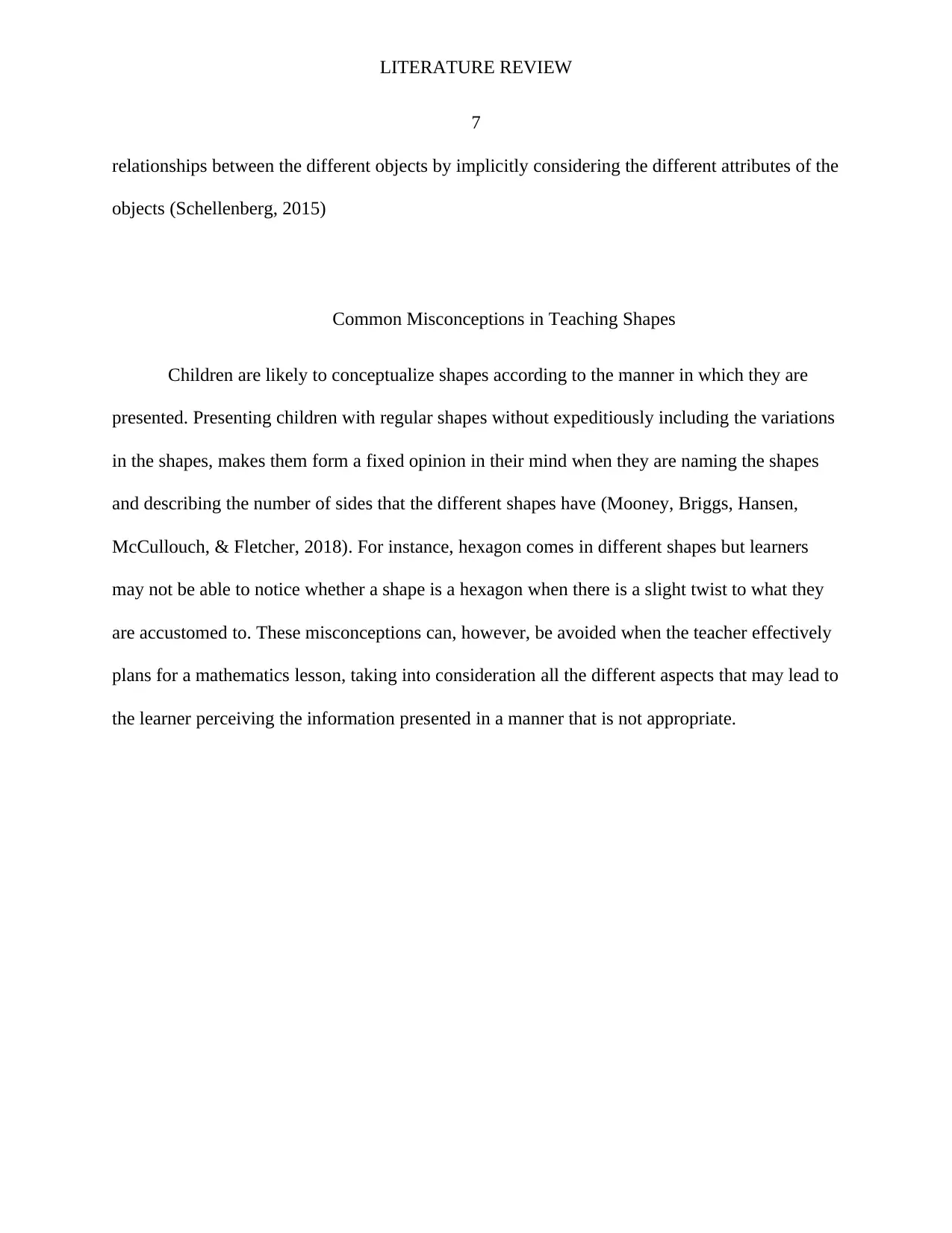
LITERATURE REVIEW
7
relationships between the different objects by implicitly considering the different attributes of the
objects (Schellenberg, 2015)
Common Misconceptions in Teaching Shapes
Children are likely to conceptualize shapes according to the manner in which they are
presented. Presenting children with regular shapes without expeditiously including the variations
in the shapes, makes them form a fixed opinion in their mind when they are naming the shapes
and describing the number of sides that the different shapes have (Mooney, Briggs, Hansen,
McCullouch, & Fletcher, 2018). For instance, hexagon comes in different shapes but learners
may not be able to notice whether a shape is a hexagon when there is a slight twist to what they
are accustomed to. These misconceptions can, however, be avoided when the teacher effectively
plans for a mathematics lesson, taking into consideration all the different aspects that may lead to
the learner perceiving the information presented in a manner that is not appropriate.
7
relationships between the different objects by implicitly considering the different attributes of the
objects (Schellenberg, 2015)
Common Misconceptions in Teaching Shapes
Children are likely to conceptualize shapes according to the manner in which they are
presented. Presenting children with regular shapes without expeditiously including the variations
in the shapes, makes them form a fixed opinion in their mind when they are naming the shapes
and describing the number of sides that the different shapes have (Mooney, Briggs, Hansen,
McCullouch, & Fletcher, 2018). For instance, hexagon comes in different shapes but learners
may not be able to notice whether a shape is a hexagon when there is a slight twist to what they
are accustomed to. These misconceptions can, however, be avoided when the teacher effectively
plans for a mathematics lesson, taking into consideration all the different aspects that may lead to
the learner perceiving the information presented in a manner that is not appropriate.
Paraphrase This Document
Need a fresh take? Get an instant paraphrase of this document with our AI Paraphraser
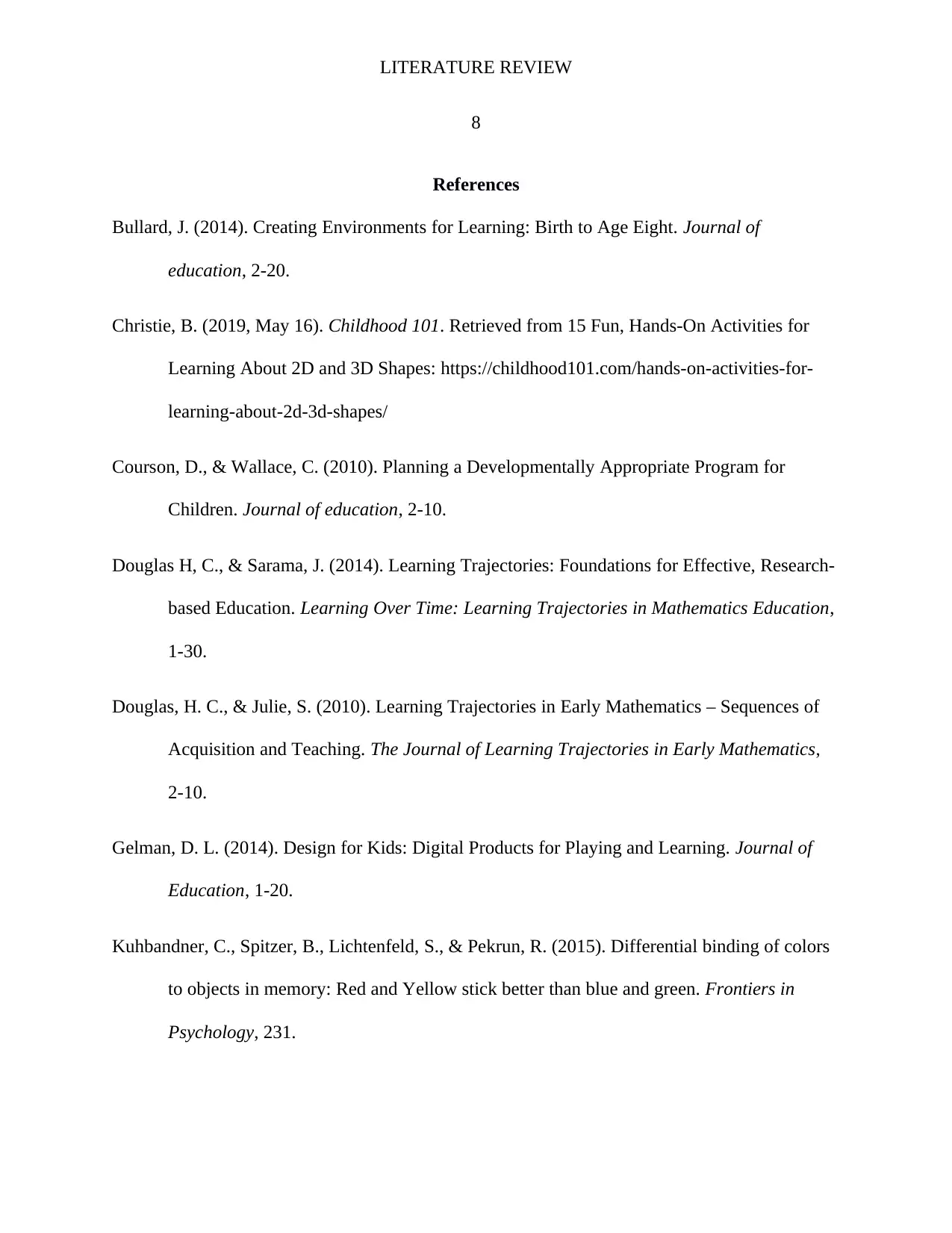
LITERATURE REVIEW
8
References
Bullard, J. (2014). Creating Environments for Learning: Birth to Age Eight. Journal of
education, 2-20.
Christie, B. (2019, May 16). Childhood 101. Retrieved from 15 Fun, Hands-On Activities for
Learning About 2D and 3D Shapes: https://childhood101.com/hands-on-activities-for-
learning-about-2d-3d-shapes/
Courson, D., & Wallace, C. (2010). Planning a Developmentally Appropriate Program for
Children. Journal of education, 2-10.
Douglas H, C., & Sarama, J. (2014). Learning Trajectories: Foundations for Effective, Research-
based Education. Learning Over Time: Learning Trajectories in Mathematics Education,
1-30.
Douglas, H. C., & Julie, S. (2010). Learning Trajectories in Early Mathematics – Sequences of
Acquisition and Teaching. The Journal of Learning Trajectories in Early Mathematics,
2-10.
Gelman, D. L. (2014). Design for Kids: Digital Products for Playing and Learning. Journal of
Education, 1-20.
Kuhbandner, C., Spitzer, B., Lichtenfeld, S., & Pekrun, R. (2015). Differential binding of colors
to objects in memory: Red and Yellow stick better than blue and green. Frontiers in
Psychology, 231.
8
References
Bullard, J. (2014). Creating Environments for Learning: Birth to Age Eight. Journal of
education, 2-20.
Christie, B. (2019, May 16). Childhood 101. Retrieved from 15 Fun, Hands-On Activities for
Learning About 2D and 3D Shapes: https://childhood101.com/hands-on-activities-for-
learning-about-2d-3d-shapes/
Courson, D., & Wallace, C. (2010). Planning a Developmentally Appropriate Program for
Children. Journal of education, 2-10.
Douglas H, C., & Sarama, J. (2014). Learning Trajectories: Foundations for Effective, Research-
based Education. Learning Over Time: Learning Trajectories in Mathematics Education,
1-30.
Douglas, H. C., & Julie, S. (2010). Learning Trajectories in Early Mathematics – Sequences of
Acquisition and Teaching. The Journal of Learning Trajectories in Early Mathematics,
2-10.
Gelman, D. L. (2014). Design for Kids: Digital Products for Playing and Learning. Journal of
Education, 1-20.
Kuhbandner, C., Spitzer, B., Lichtenfeld, S., & Pekrun, R. (2015). Differential binding of colors
to objects in memory: Red and Yellow stick better than blue and green. Frontiers in
Psychology, 231.

LITERATURE REVIEW
9
Lowrie, T., Logan, T., & Scriven, B. (2010). Perspectives in Geometry and Measurement in the
Australian Curriculum: Mathematics. Journal of Mathematics, 12-45.
Mensa Education and Research Foundation. (2010). Kindergarten Lesson Plans: Shapes. The
Journal of Early ChildDevelopment, 10.
Mooney, C., Briggs, M., Hansen, A., McCullouch, J., & Fletcher, M. (2018). Primary
Mathematics: Teaching Theory and Practice. London: Sage Publications.
Professional Development Service for Teachers. (n.d). Shapes and Space Manual. Dublin.
Schellenberg, S. (2015, August 24). Education. Retrieved from Lesson Plan: Shapes for
Kindergarten: https://www.education.com/lesson-plan/shapes-for-kindergarten/
Spelke, E., Gilmore, C., & McCarthy, S. (2011). Kindergarten Children's sensitivity to geometry
in maps. Developmental Science, 809-821.
The National Academic. (2019, May 16). PressHow Children Play. The Journal of How
Children Play, 4-23. Retrieved from How Children Play:
https://www.nap.edu/read/9853/chapter/7
UNESCO. (2018). Science and Technology Education. Journal of Education, 2-21.
UNICEF. (2009). Early Childhood Development Kit: A Treasure Box of Activities. The Journal
of Early Childhood Development, 3-9.
9
Lowrie, T., Logan, T., & Scriven, B. (2010). Perspectives in Geometry and Measurement in the
Australian Curriculum: Mathematics. Journal of Mathematics, 12-45.
Mensa Education and Research Foundation. (2010). Kindergarten Lesson Plans: Shapes. The
Journal of Early ChildDevelopment, 10.
Mooney, C., Briggs, M., Hansen, A., McCullouch, J., & Fletcher, M. (2018). Primary
Mathematics: Teaching Theory and Practice. London: Sage Publications.
Professional Development Service for Teachers. (n.d). Shapes and Space Manual. Dublin.
Schellenberg, S. (2015, August 24). Education. Retrieved from Lesson Plan: Shapes for
Kindergarten: https://www.education.com/lesson-plan/shapes-for-kindergarten/
Spelke, E., Gilmore, C., & McCarthy, S. (2011). Kindergarten Children's sensitivity to geometry
in maps. Developmental Science, 809-821.
The National Academic. (2019, May 16). PressHow Children Play. The Journal of How
Children Play, 4-23. Retrieved from How Children Play:
https://www.nap.edu/read/9853/chapter/7
UNESCO. (2018). Science and Technology Education. Journal of Education, 2-21.
UNICEF. (2009). Early Childhood Development Kit: A Treasure Box of Activities. The Journal
of Early Childhood Development, 3-9.
⊘ This is a preview!⊘
Do you want full access?
Subscribe today to unlock all pages.

Trusted by 1+ million students worldwide
1 out of 9
Related Documents
Your All-in-One AI-Powered Toolkit for Academic Success.
+13062052269
info@desklib.com
Available 24*7 on WhatsApp / Email
![[object Object]](/_next/static/media/star-bottom.7253800d.svg)
Unlock your academic potential
Copyright © 2020–2025 A2Z Services. All Rights Reserved. Developed and managed by ZUCOL.





